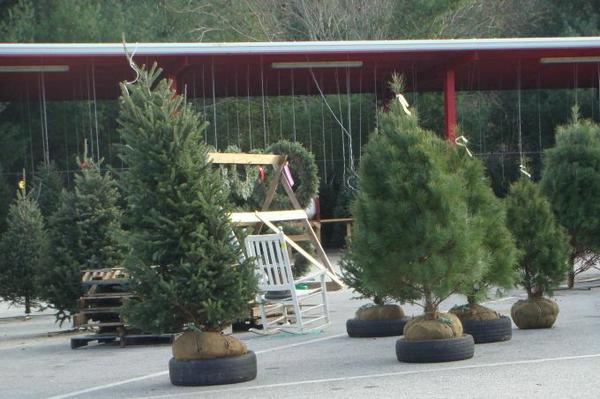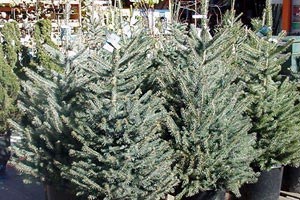Why Is It So Tricky to Have a Living Christmas Tree?
By Gil Medeiros, Former Fairfax Master Gardener
 If you are even slightly environmentally conscious, you have probably considered having a living Christmas tree. A living tree is one that is grown in a container, used inside the house for the Christmas celebration, and then planted in the landscape when the season is over.
If you are even slightly environmentally conscious, you have probably considered having a living Christmas tree. A living tree is one that is grown in a container, used inside the house for the Christmas celebration, and then planted in the landscape when the season is over.
Maybe you went online and found some befuddling instructions. You discovered, to your chagrin, that it is much more complicated than you expected.
You are advised:
- Be careful of the type of tree you select. It must be cold hardy, and it must be well suited to the conditions where you intend to plant it.
- Don’t bring the tree inside too early or keep it inside for more than a week.
- Lower the thermostat in the house, or find a cool corner for the tree.
- Consider not using incandescent lights on it.
- Keep it well watered, but do not flood the roots.
- Don’t plant it in the ground right after you move it outside.
- Put the tree in a mulch-filled trench if it is going outside.
- Better yet, keep the tree in the garage until spring comes.
At this point maybe you tossed this into the Yuletide “too hard” box along with the idea of hosting Christmas dinner for the extended family. Maybe you hauled the perpetually decorated artificial tree from the closet. It looked great in 1997 but is a little dusty now.
Even after surrendering to the artificial tree, you are left a bit puzzled. Surely, it can’t be that hard to celebrate with a living tree and later unite it with the earth to be part of the landscape.
The point of this piece is to explain the complicating factors so if you elect to have a living tree, you have a good chance of having your tree survive the holiday and beyond.
Some of this is easy to understand. A living Christmas tree, like any plant brought inside for the winter, must be well watered. The inside climate of most homes in winter is dry as Death Valley. Any plant will lose moisture fast in this environment, so many of the cautions are common sense. The tree needs plentiful water at its roots to replace the water it is losing through transpiration. But most of the candidate trees do not do well when their roots have so much water that air is excluded from the growing medium. Water when the soil surface feels dry to the touch. Also, remember that cooler temperatures inside your home help the health of the tree by diminishing the rate of water loss.

Container-grown conifers that could be used as living Christmas trees
The rest of the story may not be so obvious; it is about dormancy and cold hardiness. Conifers go dormant in winter. You thought only deciduous trees went dormant in winter. Wrong! First, we need to define “dormancy.” Dormancy is a state in which the tree stops growing. Technically, it means that the living cells in buds and beneath the bark stop dividing and elongating. Although most conifers retain their needles through the winter, they begin to shut down growth –- go dormant — in summer as the days become shorter. Dormancy, then, is regulated by photoperiod, the amount of time the tree intercepts sunlight during the day.
How well the tree responds to cold depends upon genetics. This is why it is important to select a living Christmas tree from species that thrive in our USDA zone 7 — at least. If the tree is going to survive some period of winter cold outside in a CONTAINER, it is wise to find a tree that is hardy to zone 5. Why? Because tree roots, normally protected by the insulation of the ground, are less hardy than top growth. The rule of thumb is that roots are about two USDA zones (20 degrees Fahrenheit) less hardy than top growth. Cold that the top growth can survive is often enough to kill the roots in a container-grown plant. This is why container trees must have their roots well insulated with mulch if they are to go back outside for the remainder of winter. Hence you are advised to put the tree in a pre-dug trench with plenty of mulch insulation to protect the roots.
Going dormant prepares the tree for what comes next: developing cold hardiness. This critical process is triggered and driven by the advent of colder weather. The tree hardens itself to cold gradually by producing chemicals, mainly sugars, and storing them in the fluids that are both inside and outside the living cells. Living plant tissues usually die from cold because the water OUTSIDE the cells freezes. This causes a chemical imbalance between the inside and the outside of the cells. Water diffuses through cell walls from the inside to the outside to correct the imbalance. As this response to freezing conditions outside the cell continues, the cell becomes dehydrated just as it would if it were in a severe drought. In extreme cases the cell collapses and dies from lack of water.
So as weather becomes steadily colder, the tree stores up chemicals that help it cope with the cold. By the time we get to the winter holidays, the tree is ready for the bitter cold that comes during January. However, when a tree is brought into a warm building to be used as a holiday decoration, it acts as though spring has arrived and begins to ready itself for the growing season. It quickly reverses the storage processes that made it ready for the cold, and it loses much of its cold hardiness. The longer the tree is exposed to warmth, the less hardy it becomes.
Now, if the tree is brought back outside to endure the winter cold of January, it has lost its defenses. It is in serious danger of freezing to death.
So pay heed to those cautions, and you will be able to sing “Tannenbaum O Tannenbaum” in honor of your living tree during the holidays, and later to watch as your little conifer adds beauty to your landscape.
References
• Species for Christmas Tree Planting in Virginia, VCE 420-082 (Although this publication is intended for
commercial growers, it provides a useful list of trees for homeowners who want a living tree)
• Caring for a Live Christmas Tree, University of Maryland Extension, Home and Garden Mimeo #HG 46
• Living Christmas Trees: Another real tree option, Michigan State University Extension
• Selection and Care of Living Christmas Trees, North Carolina State Extension
• Frost Hardiness and Dormancy in Conifers, C. Glerum, Ontario Tree Improvement and Forest Biomass
Institute, Ontario Ministry of Natural Resources, Maple, Ontario
updated 2020